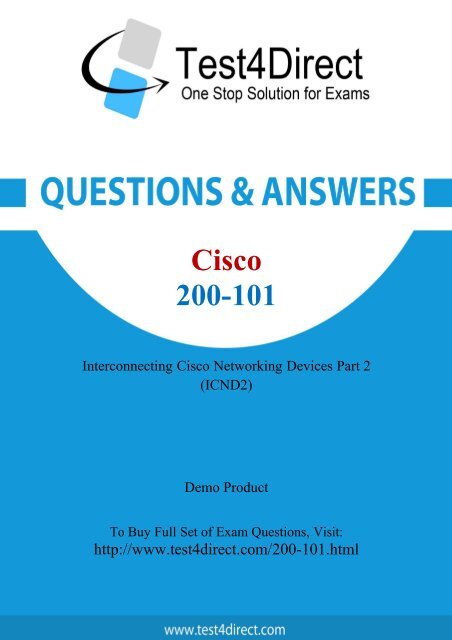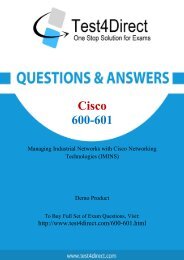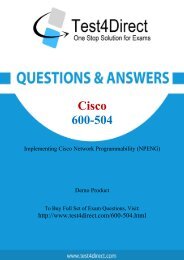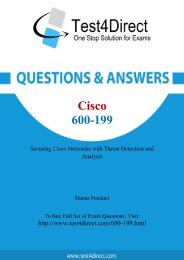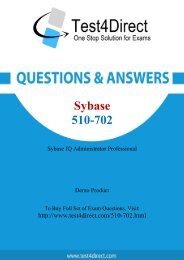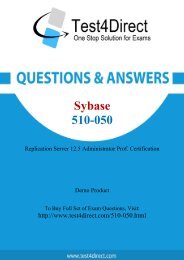Buy 200-101 BrainDumps and Get Discount
Test4Direct provides latest PDF questions of Cisco 200-101 exam. You have an opportunity to pass the Cisco 200-101 exam in one go. Test4Direct is most accurate source to prepare Cisco 200-101 exam as your success will become site’s responsibility after purchasing 200-101 exam product. There are also lots of discounts and promotion offers that you can avail. Let’s try a free demo http://www.test4direct.com/200-101.html
Test4Direct provides latest PDF questions of Cisco 200-101 exam. You have an opportunity to pass the Cisco 200-101 exam in one go. Test4Direct is most accurate source to prepare Cisco 200-101 exam as your success will become site’s responsibility after purchasing 200-101 exam product. There are also lots of discounts and promotion offers that you can avail. Let’s try a free demo http://www.test4direct.com/200-101.html
Create successful ePaper yourself
Turn your PDF publications into a flip-book with our unique Google optimized e-Paper software.
Cisco<br />
<strong>200</strong>-<strong>101</strong><br />
Interconnecting Cisco Networking Devices Part 2<br />
(ICND2)<br />
Demo Product<br />
To <strong>Buy</strong> Full Set of Exam Questions, Visit:<br />
http://www.test4direct.com/<strong>200</strong>-<strong>101</strong>.html
Question: 1<br />
Refer to the exhibit.<br />
Why has this switch not been elected the root bridge for VLAN1?<br />
A. It has more than one interface that is connected to the root network segment.<br />
B. It is running RSTP while the elected root bridge is running 802.1d spanning tree.<br />
C. It has a higher MAC address than the elected root bridge.<br />
D. It has a higher bridge ID than the elected root bridge.<br />
Question: 2<br />
Answer: D<br />
Explanation:<br />
http://www.cisco.com/en/US/tech/tk389/tk621/technologies_tech_note09186a008009482f.shtml<br />
When a switch receives a BPDU, it first compares priority, the lower number wins. If a tie, compare<br />
MAC, the smaller one wins. Here Switch has 32769 priority which is greater than 20481 so switch will<br />
not elect for root bridge. It says the bridge priority for Switch is 32769, <strong>and</strong>the root priority is 20481.<br />
Which means that some other switch has the lower priority <strong>and</strong> won the election for VLAN 1.
Which switch provides the spanning-tree designated port role for the network segment that services<br />
the printers?<br />
A. Switch1<br />
B. Switch2<br />
C. Switch3<br />
D. Switch4<br />
Question: 3<br />
Answer: C<br />
Explanation:<br />
First, the question asks what switch services the printers, so it can be Switch 3 or Switch 4 which is<br />
connected directly to the Printers. Designated port is a port that is in the forwarding state. All ports<br />
of the root bridge are designated ports. Switch 3 <strong>and</strong> Switch 4 has same priority so it will see on<br />
lowest MAC address <strong>and</strong> here switch 3 has lowest MAC address. So switch 3 segment will play a<br />
Designated port role. By comparing the MAC address of Switch 3 <strong>and</strong> Switch 4 we found that the<br />
MAC of Switch 3 is smaller. Therefore the interface connected to the Printers of Switch 3 will become<br />
designated interface <strong>and</strong> the interface of Switch 4 will be blocked.<br />
Refer to the exhibit.<br />
At the end of an RSTP election process, which access layer switch port will assume the discarding<br />
role?<br />
A. Switch3, port fa0/1<br />
B. Switch3, port fa0/12<br />
C. Switch4, port fa0/11<br />
D. Switch4, port fa0/2<br />
E. Switch3, port Gi0/1<br />
F. Switch3, port Gi0/2<br />
Answer: C
Explanation:<br />
In this question, we only care about the Access Layer switches (Switch3 & 4). Switch 3 has a lower<br />
bridge ID than Switch 4 (because the MAC of Switch3 is smaller than thatof Switch4) so both ports of<br />
Switch3 will be in forwarding state. The alternative port will surely belong to Switch4. Switch4 will<br />
need to block one of its ports to avoid a bridging loop between the two switches. But how does<br />
Switch4 select its blocked port? Well, the answer is based on the BPDUs it receives from Switch3. A<br />
BPDU is superior than another if it has:<br />
1. A lower Root Bridge ID<br />
2. A lower path cost to the Root<br />
3. A lower Sending Bridge ID<br />
4. A lower Sending Port ID<br />
These four parameters are examined in order.<br />
In this specific case, all the BPDUs sent by Switch3 have the same Root Bridge ID, the same path cost<br />
to the Root <strong>and</strong> the same Sending Bridge ID. The only parameter left to select the best one is the<br />
Sending Port ID (Port ID = port priority + port index). In this case the port priorities are equal because<br />
they use the default value, so Switch4 will compare port index values, which are unique to each port<br />
on the switch, <strong>and</strong> because Fa0/12 is inferior to Fa0/1, Switch4 will select the port connected with<br />
Fa0/1 (of Switch3) as its root port <strong>and</strong> block the other port -> Port fa0/11 of Switch4 will be blocked<br />
(discarding role)<br />
Question: 4<br />
Refer to the exhibit.<br />
Given the output shown from this Cisco Catalyst 2950, what is the reason that interface FastEthernet<br />
0/10 is not the root port for VLAN 2?<br />
A. This switch has more than one interface connected to the root network segment in VLAN 2.<br />
B. This switch is running RSTP while the elected designated switch is running 802.1d Spanning Tree.<br />
C. This switch interface has a higher path cost to the root bridge than another in the topology.<br />
D. This switch has a lower bridge ID for VLAN 2 than the elected designated switch.<br />
Question: 5<br />
Answer: C<br />
Explanation:<br />
These four parameters are examined in order to make root bridge , root port , designated port. Other<br />
switch has lowest Sending Bridge ID or Sending Port ID so vlan 2 is not the root port.<br />
1. A lower Root Bridge ID2. A lower path cost to the Root3. A lower Sending Bridge ID4. A lower<br />
Sending Port ID<br />
Which two of these statements regarding RSTP are correct? (Choose two.)
A. RSTP cannot operate with PVST+.<br />
B. RSTP defines new port roles.<br />
C. RSTP defines no new port states.<br />
D. RSTP is a proprietary implementation of IEEE 802.1D STP.<br />
E. RSTP is compatible with the original IEEE 802.1D STP.<br />
Question: 6<br />
Answer: B,E<br />
Explanation:<br />
http://www.cisco.com/en/US/tech/tk389/tk621/technologies_white_paper09186a0080094cfa.shtml<br />
Port Roles The role is now a variable assigned to a given port. The root port <strong>and</strong> designated port roles<br />
remain, while the blocking port role is split into the backup <strong>and</strong> alternate port roles. The Spanning<br />
Tree Algorithm (STA) determines the role of a port based on Bridge Protocol Data Units (BPDUs). In<br />
order to simplify matters, the thing to remember about a BPDU is there is always a method to<br />
compare any two of them <strong>and</strong> decide whether one is more useful than the other. This is based on the<br />
value stored in the BPDU <strong>and</strong> occasionally on the port on which they are received. This considered,<br />
the information in this section explains practical approaches to port roles.<br />
Compatibility with 802.1D RSTP is able to interoperate with legacy STP protocols. However, it is<br />
important to note that the inherent fast convergence benefits of 802.1w are lost when it interacts<br />
with legacy bridges.<br />
Refer to the exhibit.<br />
Each of these four switches has been configured with a hostname, as well as being configured to run<br />
RSTP. No other configuration changes have been made. Which three of these show the correct RSTP<br />
port roles for the indicated switches <strong>and</strong> interfaces? (Choose three.)<br />
A. SwitchA, Fa0/2, designated<br />
B. SwitchA, Fa0/1, root<br />
C. SwitchB, Gi0/2, root<br />
D. SwitchB, Gi0/1, designated
E. SwitchC, Fa0/2, root<br />
F. SwitchD, Gi0/2, root<br />
Question: 7<br />
Answer: A,B,F<br />
Explanation:<br />
The question says "no other configuration changes have been made" so we can underst<strong>and</strong> these<br />
switches have the same bridge priority. SwitchC has lowest MAC address so, it will become root<br />
bridge <strong>and</strong> 2 of its ports (Fa0/1 & Fa0/2) will be designated ports (DP). Because SwitchC is the root<br />
bridge the 2 ports nearest SwitchC on SwitchA (Fa0/1) <strong>and</strong> SwitchD (Gi0/2) will be root ports (RP) -> B<br />
<strong>and</strong> F are correct.<br />
SwitchB must have a root port so which port will it choose? To answer this question we need to know<br />
about STP cost <strong>and</strong> port cost. In general, "cost" is calculated based on b<strong>and</strong>width of the link. The<br />
higher the b<strong>and</strong>width on a link, the lower the value of its cost. Below are the cost values you should<br />
memorize:<br />
Link speed Cost SwitchB will choose the interface with lower cost to the root bridge as the root port<br />
so we must calculate the cost on interface Gi0/1 & Gi0/2 of SwitchB to the root bridge. This<br />
can be calculated from the "cost to the root bridge" of each switch because a switch always<br />
advertises its cost to the root bridge in its BPDU. The receiving switch will add its local port cost value<br />
to the cost in the BPDU. SwitchC advertises its cost to the root bridge with a value of 0. Switch D adds<br />
4 (the cost value of 1Gbps link) <strong>and</strong> advertises this value (4) to SwitchB. SwitchB adds another 4 <strong>and</strong><br />
learns that it can reach SwitchC via Gi0/1 port with a total cost of 8. The same process happens for<br />
SwitchA <strong>and</strong> SwitchB learns that it can reach SwitchC via Gi0/2 with a total cost of 23 -> Switch B<br />
chooses Gi0/1 as its root port. Now our last task is to identify the port roles of the ports between<br />
SwitchA & SwitchB. It is rather easy as the MAC address of SwitchA is lower than that of SwitchB so<br />
Fa0/2 of SwitchA will be designated port while Gi0/2 of SwitchB will be alternative port.<br />
Which port state is introduced by Rapid-PVST?<br />
A. learning<br />
B. listening<br />
C. discarding<br />
D. forwarding<br />
Answer: C<br />
Explanation:<br />
Spanning Tree from PVST+ to Rapid-PVST Migration Configuration Example<br />
Reference 1:<br />
http://www.cisco.com/en/US/products/hw/switches/ps708/products_configuration_example09186<br />
a 00807b0670.shtml<br />
Reference2:<br />
http://www.cisco.com/en/US/tech/tk389/tk621/technologies_white_paper09186a0080094cfa.shtml<br />
PVST+ is based on IEEE802.1D Spanning Tree Protocol (STP). But PVST+ has only 3 port states<br />
(discarding, learning <strong>and</strong> forwarding) while STP has 5 port states (blocking, listening, learning,<br />
forwarding <strong>and</strong> disabled). So discarding is a new port state in PVST+.
Background Information 802.1D Spanning Tree Protocol (STP) has a drawback of slow convergence.<br />
Cisco Catalyst switches support three types of STPs, which are PVST+, rapid-PVST+ <strong>and</strong> MST. PVST+ is<br />
based on IEEE802.1D st<strong>and</strong>ard <strong>and</strong> includes Cisco proprietary extensions such as BackboneFast,<br />
UplinkFast, <strong>and</strong> PortFast. Rapid-PVST+ is based on IEEE 802.1w st<strong>and</strong>ard <strong>and</strong> has a faster<br />
convergence than 802.1D. RSTP (IEEE 802.1w) natively includes most of the Cisco proprietary<br />
enhancements to the 802.1D Spanning Tree, such as BackboneFast <strong>and</strong> UplinkFast. Rapid-PVST+ has<br />
these unique features:<br />
Uses Bridge Protocol Data Unit (BPDU) version 2 which is backward compatible with the 802.1D STP,<br />
which uses BPDU version 0. All the switches generate BPDUs <strong>and</strong> send out on all the ports every 2<br />
seconds, whereas in 802.1D STP only the root bridge sends the configuration BPDUs. Port Roles—<br />
Root port, designated port, alternate port <strong>and</strong> backup port. Port States—Discarding, Learning, <strong>and</strong><br />
Forwarding. Port Types—Edge Port (PortFast), Point-to-Point <strong>and</strong> Shared port. Rapid-PVST uses RSTP<br />
to provide faster convergence. When any RSTP port receives legacy 802.1D BPDU, it falls back to<br />
legacy STP <strong>and</strong> the inherent fast convergence benefits of 802.1w are lost when it interacts with<br />
legacy bridges.<br />
Question: 8<br />
Which two states are the port states when RSTP has converged? (Choose two.)<br />
A. discarding<br />
B. listening<br />
C. learning<br />
D. forwarding<br />
E. disabled<br />
Answer: A,D<br />
Explanation:<br />
Underst<strong>and</strong>ing Rapid Spanning Tree Protocol (802.1w)<br />
http://www.cisco.com/en/US/tech/tk389/tk621/technologies_white_paper09186a0080094cfa.shtml<br />
Port States There are only three port states left in RSTP that correspond to the three possible<br />
operational states. The 802.1D disabled, blocking, <strong>and</strong> listening states are merged into a unique<br />
802.1w discarding state. RSTP only has 3 port states which are discarding, learning <strong>and</strong> forwarding.<br />
When RSTP has converged there are only 2 port states left:<br />
discarding <strong>and</strong> forwarding.<br />
Question: 9<br />
Which three statements about RSTP are true? (Choose three.)<br />
A. RSTP significantly reduces topology reconverging time after a link failure.
B. RSTP exp<strong>and</strong>s the STP port roles by adding the alternate <strong>and</strong> backup roles.<br />
C. RSTP port states are blocking, discarding, learning, or forwarding.<br />
D. RSTP provides a faster transition to the forwarding state on point-to-point links than STP does.<br />
E. RSTP also uses the STP proposal-agreement sequence.<br />
F. RSTP uses the same timer-based process as STP on point-to-point links.<br />
Question: 10<br />
Question: 11<br />
Answer: A,B,D<br />
Explanation:<br />
http://www.cisco.com/en/US/tech/tk389/tk621/technologies_white_paper09186a0080094cfa.shtml<br />
Convergence Cisco enhanced the original 802.1D specification with features such as Uplink Fast,<br />
Backbone Fast, <strong>and</strong> Port Fast to speed up the convergence time of a bridged network. The drawback<br />
is that these mechanisms are proprietary <strong>and</strong> need additional configuration.<br />
Alternate <strong>and</strong> Backup Port Roles These two port roles correspond to the blocking state of 802.1D. A<br />
blocked port is defined as not being the designated or root port. A blocked port receives a more<br />
useful BPDU than the one it sends out on its segment.<br />
Remember that a port absolutely needs to receive BPDUs in order to stay blocked. RSTP introduces<br />
these two roles for this purpose. Rapid Transition to Forwarding State Rapid transition is the most<br />
important feature introduced by 802.1w. The legacy STA passively waited for the network to<br />
converge before it turned a port into the forwarding state. The achievement of faster convergence<br />
was a matter of tuning the conservative default parameters (forward delay <strong>and</strong> max_age timers) <strong>and</strong><br />
often put the stability of the network at stake. The new rapid STP is able to actively confirm that a<br />
port can safely transition to the forwarding state without having to rely on any timer configuration.<br />
There is now a real feedback mechanism that takes place between RSTP-compliant bridges. In order<br />
to achieve fast convergence on a port, the protocol relies upon two new variables:<br />
edge ports <strong>and</strong> link type.<br />
At which layer of the OSI model is RSTP used to prevent loops?<br />
A. physical<br />
B. data link<br />
C. network<br />
D. transport<br />
Answer: B<br />
Explanation:<br />
RSTP <strong>and</strong> STP operate on switches <strong>and</strong> are based on the exchange of Bridge Protocol Data Units<br />
(BPDUs) between switches. One of the most important fields in BPDUs is the Bridge Priority in which<br />
the MAC address is used to elect the Root Bridge, RSTP operates at Layer 2.<br />
http://www.cisco.com/en/US/tech/tk389/tk621/technologies_white_paper09186a0080094cfa.sht<br />
ml<br />
What is one benefit of PVST+?<br />
A. PVST+ supports Layer 3 load balancing without loops.
B. PVST+ reduces the CPU cycles for all the switches in the network.<br />
C. PVST+ allows the root switch location to be optimized per VLAN.<br />
D. PVST+ automatically selects the root bridge location, to provide optimized b<strong>and</strong>width usage.<br />
Question: 12<br />
Question: 13<br />
Answer: C<br />
Explanation:<br />
Per VLAN Spanning Tree (PVST) Introduction<br />
http://www.cisco.com/en/US/tech/tk389/tk621/tk846/tsd_technology_support_subprotocol_home.<br />
html<br />
Per VLAN Spanning Tree (PVST) maintains a spanning tree instance for each VLAN configured in the<br />
network. This means a switch can be the root bridge of a VLAN while another switch can be the root<br />
bridge of other VLANs in a common topology. For example, Switch 1 can be the root bridge for Voice<br />
data while Switch 2 can be the root bridge for Video data. If designed correctly, it can optimize the<br />
network traffic. http://www.ciscopress.com/articles/article.asp?p=102157&seqNum=4<br />
Which three statements are typical characteristics of VLAN arrangements? (Choose three.)<br />
A. A new switch has no VLANs configured.<br />
B. Connectivity between VLANs requires a Layer 3 device.<br />
C. VLANs typically decrease the number of collision domains.<br />
D. Each VLAN uses a separate address space.<br />
E. A switch maintains a separate bridging table for each VLAN.<br />
F. VLANs cannot span multiple switches.<br />
Answer: B,D,E<br />
Explanation:<br />
By default, all ports on a new switch belong to VLAN 1 (default & native VLAN). There are also some<br />
well-known VLANs (for example:<br />
VLAN 1002 for fddi-default; VLAN 1003 for token-ring…) configured by default -> A is not correct. To<br />
communicate between two different VLANs we need to use a Layer 3 device like router or Layer 3<br />
switch -> B is correct. VLANs don’t affect the number of collision domains, they are the same -> C is<br />
not correct. Typically, VLANs increase the number of broadcast domains.We must use a different<br />
network (or sub-network) for each VLAN. For example we can use 192.168.1.0/24 for VLAN 1,<br />
192.168.2.0/24 for VLAN 2 -> D is correct. A switch maintains a separate bridging table for each VLAN<br />
so that it can send frame to ports on the same VLAN only. For example, if a PC in VLAN 2 sends a<br />
frame then the switch look-ups its bridging table <strong>and</strong> only sends frame out of its ports which belong<br />
to VLAN 2 (it also sends this frame on trunk ports) -> E is correct. We can use multiple switches to<br />
exp<strong>and</strong> VLAN -> F is not correct.<br />
Refer to the exhibit.
The output that is shown is generated at a switch. Which three statements are true? (Choose three.)<br />
A. All ports will be in a state of discarding, learning, or forwarding.<br />
B. Thirty VLANs have been configured on this switch.<br />
C. The bridge priority is lower than the default value for spanning tree.<br />
D. All interfaces that are shown are on shared media.<br />
E. All designated ports are in a forwarding state.<br />
F. This switch must be the root bridge for all VLANs on this switch.<br />
Question: 14<br />
Question: 15<br />
Answer: A,C,E<br />
Explanation:<br />
From the output, we see that all ports are in Designated role (forwarding state) -> A <strong>and</strong> E are<br />
correct. The comm<strong>and</strong> “show spanning-tree vlan 30 only shows us information about VLAN 30. We<br />
don’t know how many VLAN exists in this switch -> B is not correct. The bridge priority of this switch<br />
is 24606 which is lower than the default value bridge priority 32768 -> C is correct. All three<br />
interfaces on this switch have the connection type “p2p”, which means Point-to-point environment –<br />
not a shared media -> D is not correct. The only thing we can specify is this switch is the root bridge<br />
for VLAN 3o but we can not guarantee it is also the root bridge for other VLANs -> F is not correct.<br />
Which term describes a spanning-tree network that has all switch ports in either the blocking or<br />
fowarding state?<br />
A. converged<br />
B. redundant<br />
C. provisioned<br />
D. spanned<br />
Answer: A<br />
Explanation:<br />
Spanning Tree Protocol convergence (Layer 2 convergence) happens when bridges <strong>and</strong> switches have<br />
transitioned to either the forwarding or blocking state. When layer 2 is converged, root bridge is<br />
elected <strong>and</strong> all port roles (Root, Designated <strong>and</strong> Non-Designated) in all switches are selected.<br />
Refer to the exhibit.
A technician has configured the FastEthernet 0/1 interface on Sw11 as an access link in VLAN 1.<br />
Based on the output from the show vlan brief comm<strong>and</strong> issued on Sw12, what will be the result of<br />
making this change on Sw11?<br />
A. Only the hosts in VLAN 1 on the two switches will be able to communicate with each other.<br />
B. The hosts in all VLANs on the two switches will be able to communicate with each other.<br />
C. Only the hosts in VLAN 10 <strong>and</strong> VLAN 15 on the two switches will be able to communicate with<br />
each other.<br />
D. Hosts will not be able to communicate between the two switches.<br />
Answer: D<br />
Explanation:<br />
VLANs are local to each switch's database, <strong>and</strong> VLAN information is not passed between switches<br />
without implementing VLAN Trunk Protocol (VTP). Trunks carry traffic from all VLANs to <strong>and</strong> from the<br />
switch by default but, can be configured to carry only specified VLAN traffic. Trunk links are required<br />
to pass VLAN information between switches. So Sw11 port should be trunk not access port.<br />
Additionally, there are no ports assigned to VLAN 1.
THANKS FOR TRYING THE DEMO OF OUR PRODUCT<br />
Visit Our Site to Purchase the Full Set of Actual <strong>200</strong>-<strong>101</strong> Exam Questions With Answers.<br />
http://www.test4direct.com/<strong>200</strong>-<strong>101</strong>.html<br />
We Also Provide Practice Exam Software That Simulates Real Exam Environment And Has<br />
Many Self-Assessment Features. Download Free Product Demo From:<br />
http://www.test4direct.com/<strong>200</strong>-<strong>101</strong>.html<br />
Money Back Guarantee<br />
Check Out Our Customer Testimonials


